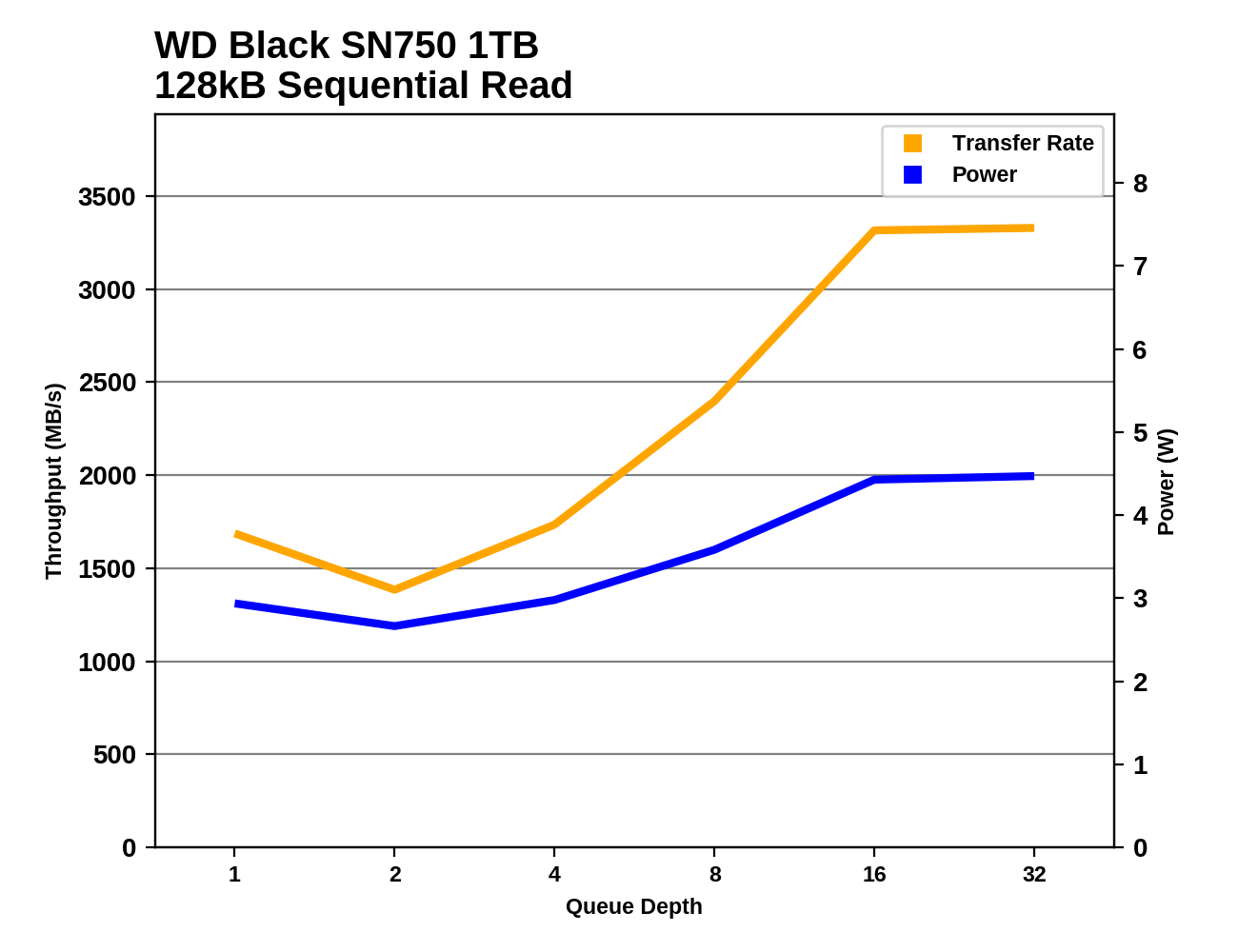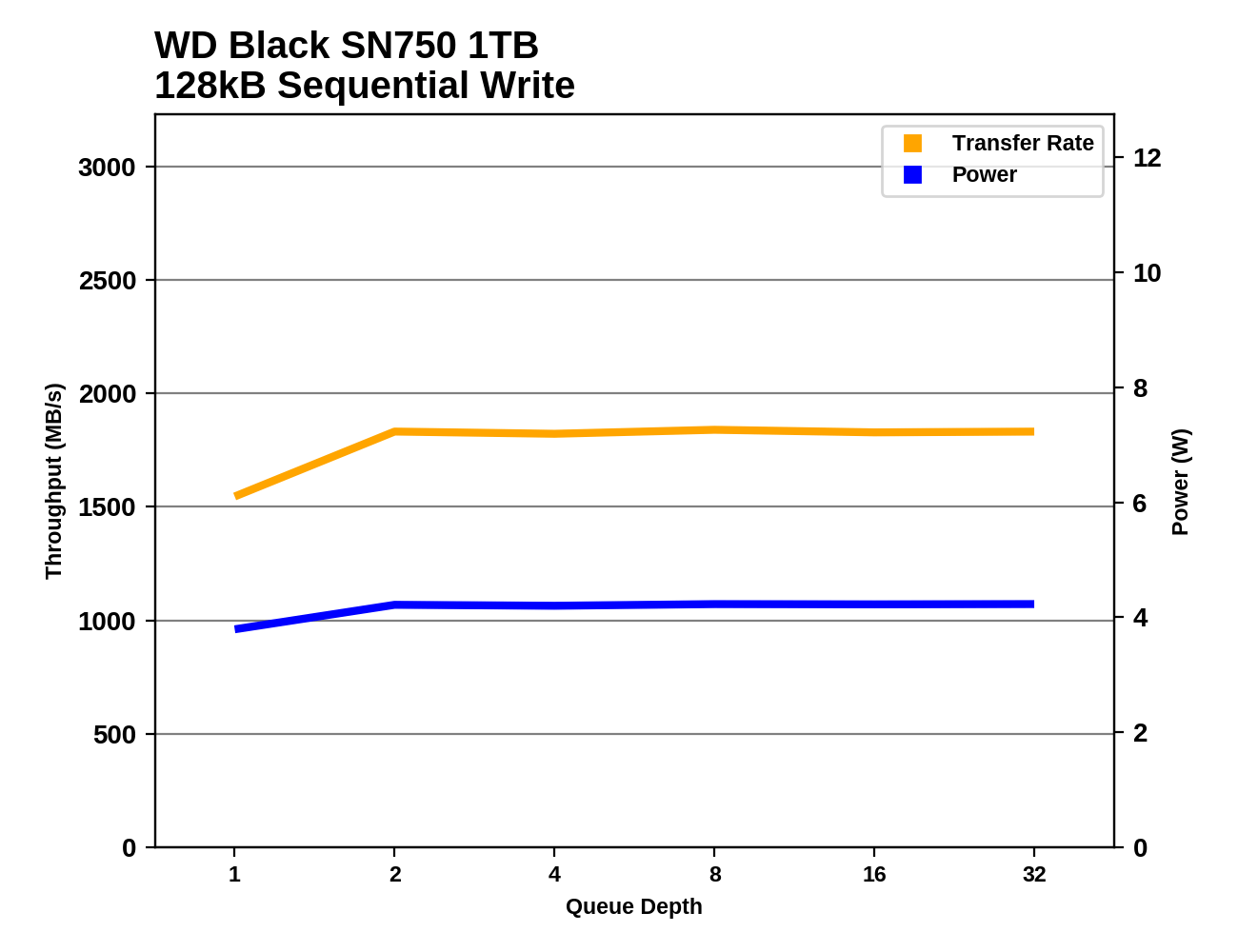The Western Digital WD Black SN750 SSD Review: Why Fix What Isn't Broken?
by Billy Tallis on January 18, 2019 8:01 AM ESTSequential Read Performance
Our first test of sequential read performance uses short bursts of 128MB, issued as 128kB operations with no queuing. The test averages performance across eight bursts for a total of 1GB of data transferred from a drive containing 16GB of data. Between each burst the drive is given enough idle time to keep the overall duty cycle at 20%.

The queue depth 1 burst sequential read performance of the WD Black SN750 is faster than its predecessor, but there's still a lot of room for improvement relative to the fastest TLC SSDs and even the Corsair MP510 that relies on the same BiCS3 NAND as the SN750.
Our test of sustained sequential reads uses queue depths from 1 to 32, with the performance and power scores computed as the average of QD1, QD2 and QD4. Each queue depth is tested for up to one minute or 32GB transferred, from a drive containing 64GB of data. This test is run twice: once with the drive prepared by sequentially writing the test data, and again after the random write test has mixed things up, causing fragmentation inside the SSD that isn't visible to the OS. These two scores represent the two extremes of how the drive would perform under real-world usage, where wear leveling and modifications to some existing data will create some internal fragmentation that degrades performance, but usually not to the extent shown here.

The performance of the WD Black SN750 on the longer sequential read test is a bit better than the previous model and more in line with other drives that use the same NAND, but still much slower than the top NVMe drives on this test. The performance when reading data that was not written to the drive sequentially has regressed slightly but is still decent for this class of drive.
 |
|||||||||
| Power Efficiency in MB/s/W | Average Power in W | ||||||||
Despite relatively low performance, the SN750 still manages to be tied for second place in the power efficiency ranking, scoring about 13% lower than the Toshiba XG6.
 |
|||||||||
The WD Black SN750 suffers during the early stages of the sequential read test and doesn't hit its full read speed until the queue depth reaches about 16. The performance profile is very similar to last year's model save for a significant improvement at QD1. Several other drives also require fairly high queue depths to reach full speed, but most of the relevant competition has better low-QD performance than the WD Black.
Even though the WD Black starts off slow, it still is fairly power efficient throughout the sequential read test and there are only few drives that offer better performance per Watt at any speed.
Sequential Write Performance
Our test of sequential write burst performance is structured identically to the sequential read burst performance test save for the direction of the data transfer. Each burst writes 128MB as 128kB operations issued at QD1, for a total of 1GB of data written to a drive containing 16GB of data.

As with sequential reads, the QD1 burst sequential write performance of the WD Black SN750 is significantly improved over the previous model, and this time it gets relatively close to the top tier of drives.
Our test of sustained sequential writes is structured identically to our sustained sequential read test, save for the direction of the data transfers. Queue depths range from 1 to 32 and each queue depth is tested for up to one minute or 32GB, followed by up to one minute of idle time for the drive to cool off and perform garbage collection. The test is confined to a 64GB span of the drive.

The SN750 also improves slightly on the longer sequential write test that adds in some higher queue depths, bringing it up to the level of the Corsair MP510 but still a bit behind the Toshiba XG6 and well behind the fastest TLC-based competition.
 |
|||||||||
| Power Efficiency in MB/s/W | Average Power in W | ||||||||
The SN750 can't claim another efficiency win due to its performance that is merely average for this product segment, but the efficiency score is still pretty good.
 |
|||||||||
The SN750's sequential write performance increases slightly from QD1 to QD2 and remains steady for the rest of the test. The top-performing SM2262EN sample doesn't hit full speed until QD4, at which point it is faster than the SN750 by almost 1GB/s.
Among all the drives that have run through this test, the performance and power consumption of the SN750 both appear fairly middle of the road by NVMe standards; there are some drives that save almost 1W at the same speed, and a few that are far faster at similar power levels.












54 Comments
View All Comments
iwod - Friday, January 18, 2019 - link
Patiently waiting for PCI-E 5.0 SSD, that is 16GB/s for 4x.Ryan Smith - Friday, January 18, 2019 - link
So for what it's worth, the last time I talked to the PCI-SIG about PCIe 5, they were saying that they were expecting it to be used in conjunction with PCIe 4 rather than replacing it. The idea being that the PCIe x16 slot closest to the CPU would be a PCIe 5 slot, while everything else would be PCIe 4 due to the distances and signal integrity issues involved.If that's still the plan, then I wouldn't expect to see PCIe 5 SSDs, at least not in the M.2 form factor.
iwod - Saturday, January 19, 2019 - link
Thx. But surely Directly Attached NAND from SSD is more important? It is way more latency sensitive than GPU.I am wondering if we could get sort of like 20x Slot with 16x bandwidth. So 4x for SSD, and 8x * 2 for GPU.Most people are still using a single graphics card, I would be fine with 8x GPU PCI-E 5.0 and 4x for SSD.
Does that mean we might never see Thunderbolt 5 with PCI-E 5 signalling?
GreenReaper - Saturday, January 19, 2019 - link
Basically this is how PCIe 4 is likely to work for many existing AMD motherboards.ScouserPcgamer - Friday, January 18, 2019 - link
The Seagate Firecuda wipes the floor of read/write speeds, this is like a 1% improvement over the 2018 modelLogitechFan - Friday, January 18, 2019 - link
And then comes 970 Pro and wipes the floor with all of them and spits on their graves.LogitechFan - Friday, January 18, 2019 - link
970 Pro is not on the list?! WTF is this, an Intel commercial?!Oxford Guy - Friday, January 18, 2019 - link
What is and isn't tested is sometimes very strange here. The Nvidia GTX 960, for example, was never tested."Editor's Note: Due to personal matters we won’t have a GeForce GTX 960 review published today. But in lieu of that we wanted to go over the basics of NVIDIA’s latest Maxwell card"
Today or ever.
"Anyhow, that’s a wrap from us for now. Be sure to check back in early next week for our complete look at GeForce GTX 960, including performance, overclocking, HEVC support, and more."
Still waiting... Those promises were posted in 2015.
Oxford Guy - Friday, January 18, 2019 - link
"Conspiracy theorists" claimed the card wasn't tested because it was a turkey, making Nvidia look bad.Has Anandtech staff ever explained why the promised review never materialized?
Ryan Smith - Friday, January 18, 2019 - link
"Has Anandtech staff ever explained why the promised review never materialized?"Honestly, we're busy and despite our best efforts, sometimes bite off more than we can chew. Especially as we have imperfect vision about what products may show up on our doorsteps tomorrow.